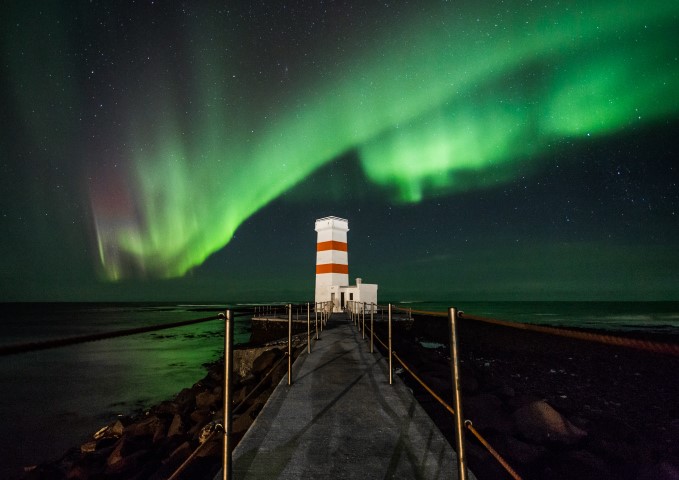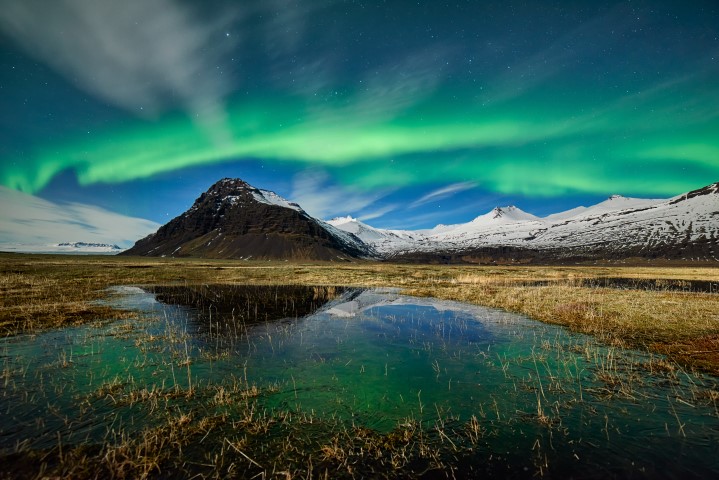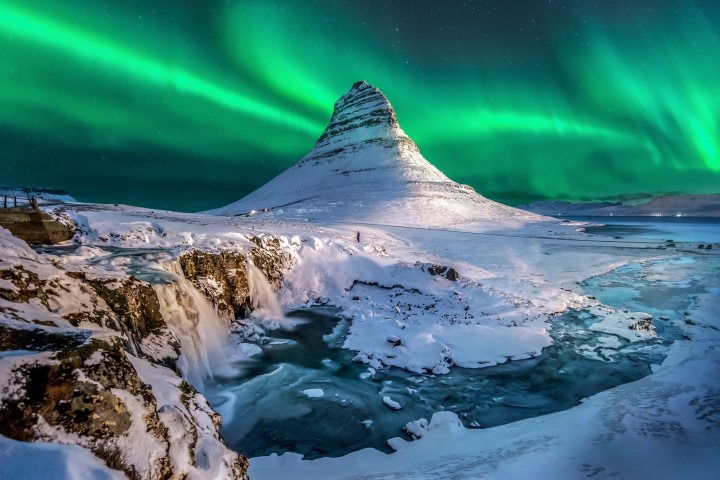Iceland is one of the best places in the world to see the Northern Lights (a.k.a. the Aurora Borealis). On clear, crisp winter nights in Iceland, you can experience the Northern Lights dancing magically across the sky. Seeing this magnificent light show with various colours dancing and twirling before your eyes is nothing short of amazing and each display is totally unique. Some say it’s a life-changing event. The Northern Lights are one of the biggest draws to visiting Iceland in the winter, the downside being that they are a natural phenomenon and thus elusive and unpredictable. Iceland is a wonderful winter destination where adventures and unique experiences await around every bend. Winter is even more special if you are fortunate enough to witness the magical Northern Lights dancing across the sky. Seeing the Northern Lights would be the cherry on top of your winter trip, a bonus to an otherwise amazing adventure with quirky experiences.

What are the Northern Lights?
The Northern Lights are caused by electrically charged particles from the sun hitting the Earth’s magnetic field. This ‘solar wind’ is funnelled down to the magnetic poles of the northern and southern hemispheres. Their intensity depends on the activity of the sun, and the acceleration speed of these particles. As a result, energy is released and causing peculiar luminous green streaks across the skies. The Northern Lights appear in the magnetic polar regions of the north and south hemispheres and their colour can vary from white, green, pink and purple. Their colours depend on the elements being ionised.
The best time to see the Northern Lights in Iceland
The Northern Lights season in Iceland is from September to mid-April. Some sources will recommend November to February as the prime time for viewing the Aurora, as they are the darkest months with the longest possible window to see the lights. However, these months also have the worst weather with lots of rain, snow and clouds. It is also not unheard of to see the lights as early as mid-August. You might want to read our article about the best time to see the Northern Lights in Iceland.
View our finest Northern Lights tour in Iceland!
Where to see the Northern Lights in Iceland
Northern Lights trips are organized around the country all winter long. There are for example numerous tour operators offering these late-night sightseeing excursions from Reykjavík, of which we recommend the Northern Lights Mystery Tour and Northern Lights Cruise. The ideal location for sightings varies and the local guides are skilled in ‘hunting’ the lights, finding locations where conditions are best for seeing them each night.
In most cases, chances of catching the Northern Lights are immediately improved outside populated areas, away from city lights. That being said, the Aurora can often be seen dancing over the capital and other towns. Most hotels around the country offer a special Northern Lights wake-up service, so if lights happen to appear, they will let you know. A longer stay in one location will also improve your chances of spotting this magical natural phenomenon. Many of our Hey Iceland accommodations cater specifically to the needs of those who want to gaze at the Northern Lights and we label them specifically as Northern Lights friendly accommodations.

What are the optimal conditions for the Northern Lights in Iceland?
Witnessing the Northern Lights in Iceland requires patience, luck and the following conditions to be met. Of course, there is a chance that even if all those conditions are in your favour and you take every opportunity you get, you still might not see the lights. That being said, you may have the luck of seeing them from the airplane or on the drive from the airport. Luck is an important factor.
Aurora activity
There must be enough solar activity for the lights to appear. The Icelandic Met Office offers a great Northern Lights forecast predicting Aurora activity for any given day on your trip to Iceland. The higher the number on the scale, the more aurora activity and the better your chance of seeing the Northern Lights. The forecast will also predict the cloud coverage for each night. Unfortunately, it is impossible to know more than a few days in advance what the forecast will be. Checking the forecast regularly in the days leading to your trip to Iceland will give you an idea of your chances for seeing the Northern Lights.
Darkness
You need darkness for viewing the Northern Lights. That is why the Northern Lights season is during winter and hunting the lights is a night-time activity. The further you get away from the city lights, the better your chances of seeing them. Standing in the vast and rugged nature away from the distracting lights also makes the experience so much better, authentic and natural.
Clear skies
Clouds will block your visibility of the Northern Lights so the sky has to be clear for you to see them. Skies are clearer if temperatures fall below zero. The Northern Lights forecast also shows you the forecast for total could cover over Iceland in a visual way so you can see where you will have the best odds of seeing the Northern Lights day by day.
The length of your stay in Iceland is also an important factor. The Northern Lights tend to be very active for 2-3 nights, then low for 4-5 nights, in ongoing cycles. So, the longer your stay the bigger your chances.

How to see the Northern Lights in Iceland
You can spot the Northern Lights…
…by walking
If the conditions above are in your favour, the Northern Lights may appear in the sky above you. Then you may not have to walk very far to enjoy a magnificent display of colourful lights. Put on your warmest jacket, hat and mittens and go for a walk. Enjoy the silence of the crisp Icelandic winter night and be amazed by the Aurora. Head for more secluded areas away from light pollution.
…by car
If you are doing a self-drive tour and have a rental car, you can drive in almost any direction in the search for the perfect spot. Just remember to drive carefully in the dark and snowy winter nights.
…on a guided tour
If you like organized tours and want to be in the safe hands of a local guide, you can book a scheduled Northern Lights tour a number of tour operators. The guides are skilled in ‘hunting’ for the Northern Lights and knowing the best locations to spot them based on each night’s Aurora and weather forecast.
… on a boat
A Northern Lights hunt at sea is an amazing experience and you will find a few operators offering these amazing tours. Great scenery and absolutely unique experience.
…in the countryside
You can stay at an Icelandic countryside accommodation for a few days to maximise your chances of seeing the Northern Lights away from the city lights. Enjoy the warm atmosphere of an Icelandic farm, get to know the locals, explore nearby natural attractions by day and hunt for the Northern Lights by night.
Scheduled tours (vs self-driving)
Northern Lights tours are scheduled almost daily during winter. You can take a bus tour, super jeep experience, a boat ride, float in geothermal pools or even view them from the top of a glacier. You are bound to find at least one tour that appeals to you. There are many advantages to booking a scheduled Northern Lights tour. Guided tours have the advantage of being led by experts who closely follow the forecasts and have knowledge about road conditions and terrain. Another benefit is you won’t have to worry about driving yourself in the dark and snowy winter night. Of course, those tours will also take you to landscapes and location you may otherwise not experience.
The best time to see the Northern Lights in Iceland
The Northern lights season in Iceland is from September to April. This is when nights are dark so your chances of seeing the Northern Lights are greater. Unfortunately, no guarantees can be given as visibility depends on weather conditions. Another important factor to consider is the duration of your stay in Iceland. If you want the greatest odds of spotting they Aurora we recommend that you spend at least seven nights in the country. This is because the Auroras tend to be quite active for two to three nights in a row and then activity drops for four to five nights in ongoing cycles.
Northern Lights holiday
If you want your holiday to Iceland to be focussed on seeing the lights first-hand, there are plenty of winter self-drive vacations and package holidays that will make this a possibility. As mentioned above, the longer you stay in Iceland, the better your chances of witnessing a spectacular display of lights.
How to photograph the Northern Lights
A far as equipment goes, the most important thing you can bring is a tripod and a cable release to avoid the dreaded shaken photo syndrome. If you don’t have a cable release, set your camera’s self-timer to two or ten seconds shutter delay. There is no single setting for your camera that ensures great captures. As a rule of thumb, ISO setting between 800 and 3200, aperture between f/2.8 and f/5.6, and shutter speed at between 15 seconds and 30 seconds have proven effective.
What to bring on your Northern Lights tour
- Warm clothes
- Camera
- Tripod
- Spare batteries
- Good shoes
- Memory cards
- Snacks
- Drinks

The most popular things to do in Iceland
Since the Northern Lights are very unpredictable and no one can guarantee that you will actually see them during your stay in Iceland, it is important to incorporate other activities into your travel plan. Iceland has many amazing things to offer and you should make the most of your stay and consider spotting the Auroras as a bonus. We recommend a visit to the Golden Circle: Gullfoss Waterfall, Geysir Geothermal Area and Þingvellir National Park which are Iceland’s most popular attractions. We also recommend a drive along the south coast of Iceland where you will see some amazing natural wonders like Seljalandsfoss Waterfall, Dverghamrar Cliffs, Reynisdrangar Sea Stacks and the otherworldly Jökulsárlón Glacier Lagoon.
You can also enhance your experience in Iceland with activities that fit your travel style from adrenaline-inducing adventures to a more leisured pace. We recommend whale watching, horse riding, whitewater rafting, culinary experiences, greenhouse visits, cave exploration tours, ATV rides and snorkelling.
We at Hey Iceland are dedicated local travel experts in Iceland, ready at your service. Let us know what kind of experiences you want to have in Iceland, and we will help you plan your dream trip. If you are interested in hunting the Northern Lights in Iceland you might also be interested in our articles about why you should visit Iceland in the winter, how to survive driving in Iceland, the best time to see the Northern Lights in Iceland, and how to photograph the Northern Lights.
With this information you should be able to venture out to look for the beautiful northern lights. While your are experiencing this magnificent phenomenon please share your adventure with us @heyiceland and #heyiceland